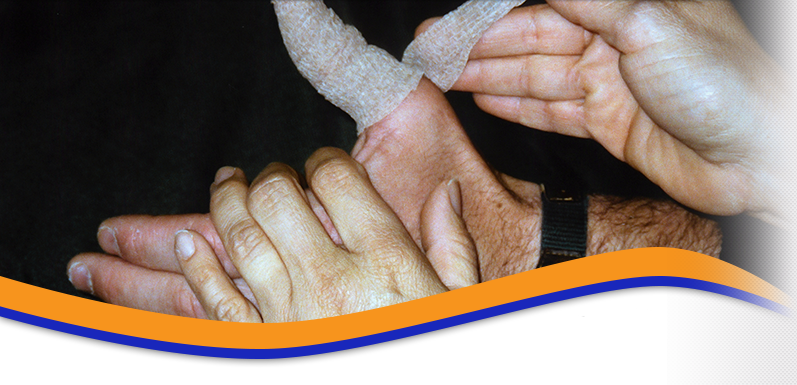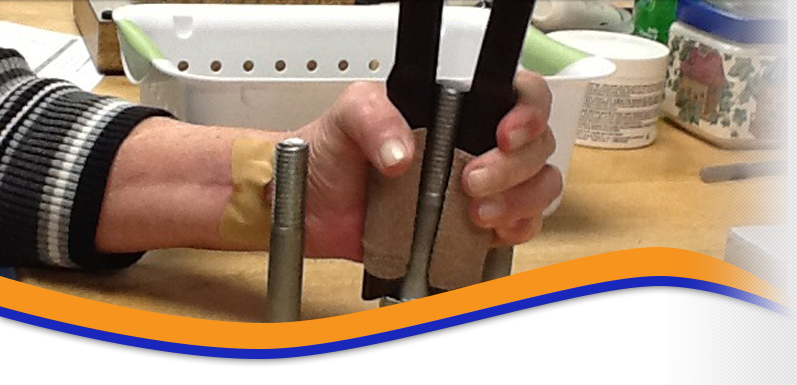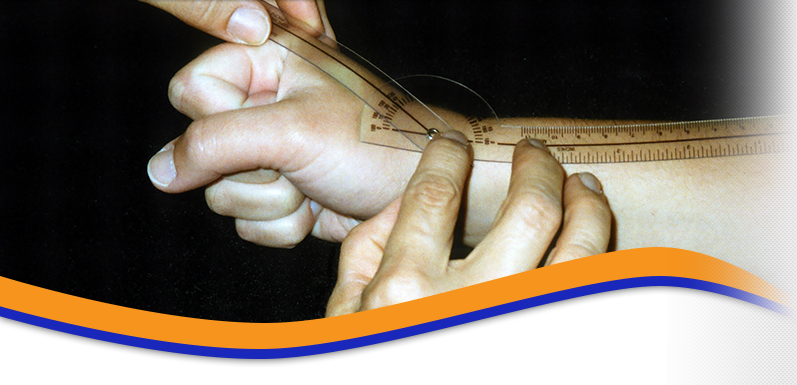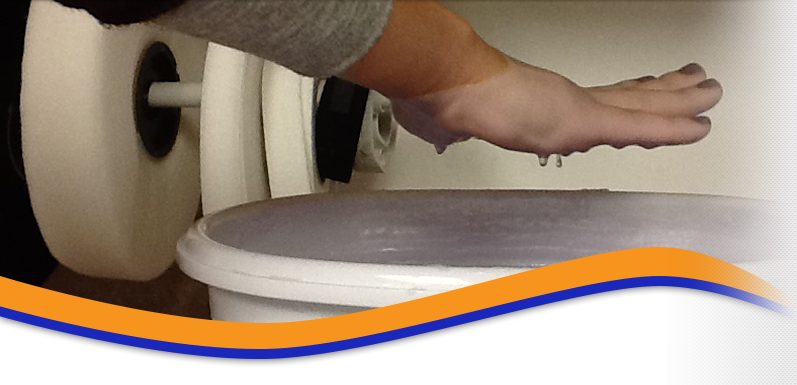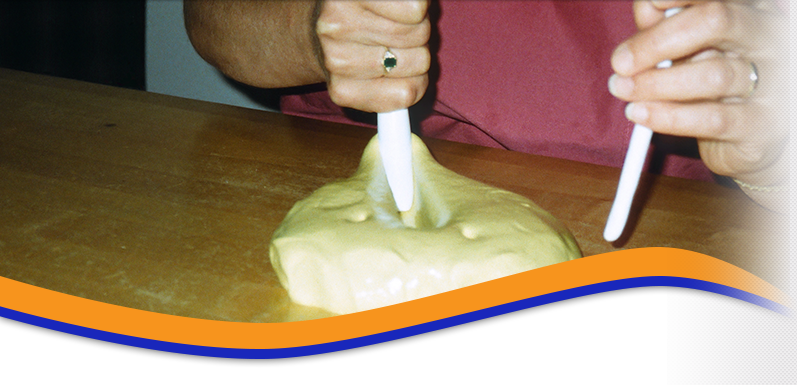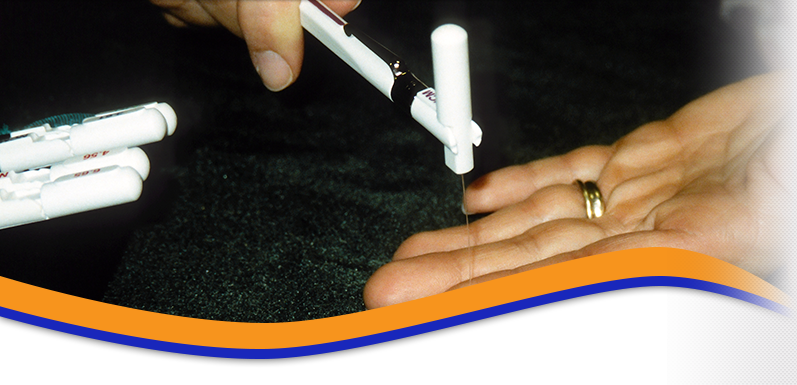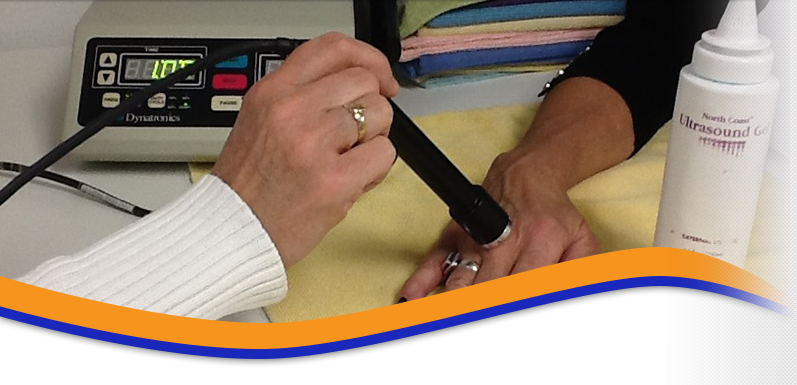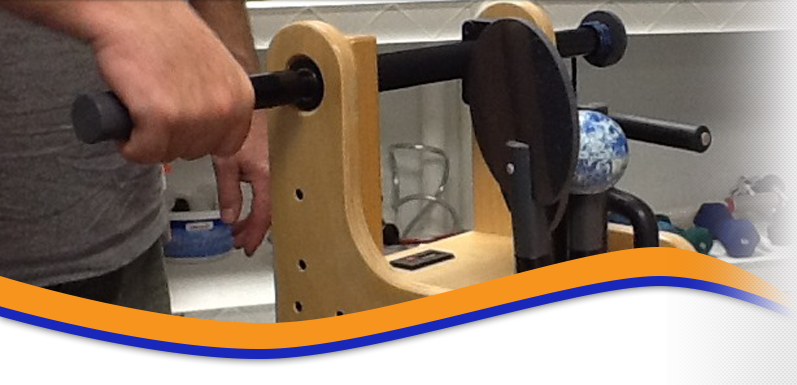Modified Kleinert
3-5 days post-op: Patient is fitted with a forearm based dorsal blocking splint with wrist at 20 degrees of flexion, MPs at 50-70 degrees of flexion and IPs in full extension. Traction is attached to fingers and holding them in flexion. Swelling control measures are taken. Patient is instructed in exercise program of passive flexion of each individual finger, and passive flexion and active extension of fingers against the resistance of the traction up to the dorsal blocking splint. Patient performs these exercises 10-20 reps every waking hour.
10-14 days post-op: Heat modalities are initiated in therapy as swelling decreases and as needed for pain and joint stiffness. Scar maturation techniques are initiated. A night strap may be added to the dorsal block to hold IPs in extension to the dorsal block if patient begins to develop a PIP flexion contracture.
3 weeks post-op: Patient is instructed in place-hold exercises outside of splint. Splint and traction are continued between exercise sessions.
4 weeks post-op: Gentle passive extension exercises to the IPs may be added in a protected position. If the difference between TAM and TPM is greater than 50 degrees patient is progressed to active tendon gliding exercises and light wrist and finger tenodesis exercises. Depending on the degree of scar tissue present the dorsal blocking splint make be discontinued or continued without the traction for protection. If the difference between TAM and TPM is 50 degrees or less the patient doesn’t have much scar tissue formation and active tendon gliding exercises may be delayed for another week and the splint is continued.
5 weeks post-op: Active tendon gliding exercises are initiated or continued. Wrist AROM is initiated. Depending on the degree of scar tissue present the dorsal blocking splint make be discontinued or continued without the traction for protection. If the difference between TAM and TPM is 50 degrees or less the patient doesn’t have much scar tissue formation and active tendon gliding exercises may be delayed for another week and the splint is continued until 6 weeks post-op.
6 weeks post-op: Dorsal blocking splint is discontinued if not already done so. Dynamic splinting for extension may be initiated. Gentle joint blocking may be initiated except to the small finger. Passive extension exercises may be added. NMES may be initiated to help facilitate tendon glide. Patient may begin to use hand for light functional activities.
7 weeks post-op: Dynamic or static progressive splinting may be continued to resolve extrinsic flexion tightness or joint stiffness. Unrestricted A/AA/PROM to wrist and fingers. Light progressive strengthening is initiated.
8 weeks post-op: Strengthening is progressed
Modified Duran
3-5 days post-op: Patient is fitted with a forearm based dorsal blocking splint with wrist at 20 degrees of flexion, MPs at 50-70 degrees of flexion and IPs in full extension. Swelling control measures are taken. Patient is instructed in exercise program of passive flexion and extension of each individual finger, at each joint and composite flexion and extension. Patient performs these exercises 10-20 reps every waking hour.
10-14 days post-op: Heat modalities are initiated in therapy as swelling decreases and as needed for pain and joint stiffness. Scar maturation techniques are initiated.
3 weeks post-op: Patient is instructed in place-hold exercises outside of splint. Dorsal blocking splint is continued between exercises.
4 weeks post-op: Active tendon gliding exercises are initiated unless minimal scar is present, i.e. TAM and TPM difference is 50 degrees or less. Ultrasound may be initiated if dense scar is present. Dorsal blocking splint is continued between exercises.
5 weeks post-op: Splint is discontinued. Active tendon gliding exercises are continued.
6 weeks post-op: Unprotected passive extension exercises may be initiated. Night dynamic extension splinting may be added if needed for extrinsic flexor tightness or joint stiffness. Blocking exercises may be added except to the small finger.
8 weeks post-op: Strengthening exercises are initiated.
Early Active Mobilization Program (Indiana Tenodesis Program)
Minimum 4 strand repair required
3 days post-op: Patient is fitted with a forearm based dorsal blocking splint with wrist in 20 degrees flexion and MPs in 65-70 flexion and IPs fully extended. The splint has a hinge at the wrist that allows full flexion and blocks wrist extension to 30 degrees. The splint is blocked with wrist at 20 degrees with a piece of splinting material. Patient is instructed in PROM of each joint of each finger and composite flexion and extension within limits of the dorsal block. The wrist block is removed and patient is instructed in tenodesis exercises passively flexing the digits in a composite fashion while simultaneously bringing the wrist into extension. Once in this position the patient is instructed to actively hold the fingers gently in a fist for 5 seconds. Then the patient relaxes the wrist and letting it drop into flexion as the fingers extend.
10-14 days post-op: Scar maturation techniques are initiated.
4 weeks post-op: Patient continues PROM within the dorsal blocking splint.
AROM is allowed outside of the splint 25 reps each every 2 hours.
Place-hold exercises.
Active composite fist with wrist in neutral followed by active straightening of fingers with wrist in neutral.
Active hook fist with wrist in neutral and straightening fingers fully with wrist neutral.
Active composite fist, followed by hook then full extension of fingers with wrist neutral.
Active wrist extension and flexion.
5 weeks post-op:
Continue above exercise and add active composite fist followed by actively extending the wrist and fingers simultaneously.
6 weeks post-op: The splint is discontinued. Joint blocking may be added unless patient has 80-85% of normal motion. Joint blocking is not permitted at small finger.
8 weeks post-op: Gentle progressive strengthening may be initiated beginning with putty and a hand exerciser.
10-12 weeks post-op: Patient is encouraged to resume normal use of the hand in all ADL activities except a tight sustained fist and/or heavy lifting which may be resumed at 14-16 weeks post-op.
Flexor Tenolysis:
1-3 days s/p: Post-op dressing is removed and AROM is initiated. (If surgeon indicates tendon is compromised place-hold exercises will be initiated and patient progressed to AROM). Swelling control measures and wound care will be addressed. Patient will be instructed to exercise hourly. Pulley ring fabricated if surgeon reports needing to repair pulley.
4 days-2 weeks s/p: AA/PROM will be added as needed to achieve full AROM, joint blocking exercises added, heat/pain modalities are used, splinting added if needed, e-stim if needed.
2-6 weeks s/p: Scar maturation techniques added as indicated, Ultrasound if needed for scar maturation
6 weeks s/p: Progressive resistive exercises are initiated to continue to facilitate tendon gliding and for strengthening.

